Noticing sand, dirt, or cloudy water from your well? You’re not alone — sediment is one of the most common well water issues out there.
And while a little grit doesn’t always mean danger, it can cause clogged pipes, worn-out appliances, and even strange-tasting water if left unchecked. The good news? Most sediment problems are fixable — and you’ve got options.
Whether it’s a cracked casing or just a filter upgrade, this guide will walk you through what causes sediment, how to test for it, and which filtration solutions actually work.
👉 Want to dig deeper into well system issues? Check out our guide to common well water problems.
⚡ Quick Takeaways
- 🌀 Spin-Down or Cartridge Filters: Great for removing visible particles like sand, dirt, and grit.
- 🧪 Ultrafiltration (UF): Removes super-fine sediment down to 0.1 microns — ideal if water looks cloudy.
- 🧰 Check Your System First: A broken screen or oversized pump might be stirring up sediment at the source.
- 💡 Test Before You Treat: Water tests help identify the exact type of sediment (like iron, manganese, or silt).
- 🔁 Layered Protection Works Best: Use pre-filters before softeners or carbon systems to prevent clogs.
🪨 What Exactly Is Sediment?
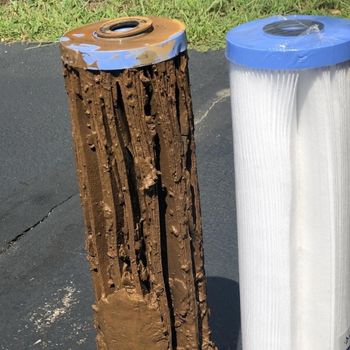
Sediment is just a fancy term for the solid stuff that ends up in your well water — some harmless, some not so much. You might spot it at the bottom of a glass or notice a gritty texture in your faucet aerators.
🧱 Common types of sediment include:
- Dirt and sand
- Gravel or small rocks
- Clay or dust
- Iron and manganese particles
- Organic matter like silt and tannins
- Hardness minerals (e.g., calcium, magnesium)
🔍 Good to Know: Some contaminants — like iron — exist in both dissolved and solid forms. Sediment filters only remove the solid stuff. For everything else, you’ll need a different filtration strategy.
🌧️ How Sediment Gets Into Your Well
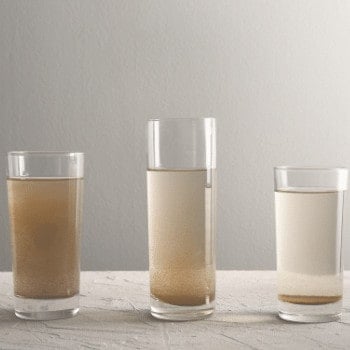
A little dirt in your well isn’t always a red flag — it’s often just groundwater doing its thing. But if you’re seeing more than a little grit, one of these issues might be the culprit:
🧩 Common causes of sediment in well water:
- Broken well screen – Your first line of defense. If it’s damaged, particles sneak in.
- Cracked casing – Even a hairline crack in your well’s casing can let in silt or debris.
- Oversized pump – Too much suction stirs up more than just water.
- Low pump placement – If the pump sits too close to the bottom, it may pull in sand and gravel.
- Rusty pipes – Corroding plumbing can flake and send particles into your tap.
- Low water levels – If your well’s running dry, you’ll get mud instead of minerals.
💡 Pro Tip: Just had a new well drilled? Some sediment is normal for the first few weeks — it’s part of the cleanup.
👀 How to Tell If You’ve Got Sediment
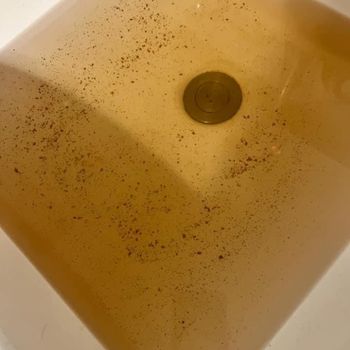
Wondering if there’s sediment in your water? Sometimes it’s obvious — other times, not so much.
🧪 Quick ways to spot it:
- Let a glass sit — If particles settle at the bottom, that’s visible sediment.
- Cloudy or hazy look — Fine particles can stay suspended, making water look murky.
- Grit in your fixtures — Debris in faucet screens or showerheads is another tell.
💡 Good to Know: Even if you can’t see it, sediment can still damage appliances and clog pipes. If in doubt, test your water — especially if the issue is sudden or worsening.
⚠️ Is Sediment in Well Water a Health Concern?
Some sediment is just annoying. But other types? They can cause real problems — or create the perfect hiding place for harmful stuff.
🔍 Here’s what might be lurking:
- 🥄 Manganese: Naturally occurring, but too much can lead to stomach issues.
- 🍂 Tannins: From decaying vegetation — safe to drink, but can make water acidic and impact plumbing.
- 🌫️ Silt: Not dangerous alone, but it can harbor bacteria like E. coli by blocking UV light during disinfection.
💡 Good to Know: Cloudy water can interfere with treatment systems. It’s not just about looks — sediment can reduce the effectiveness of filters, UV systems, and other equipment.
🏠 How Sediment Affects Your Plumbing and Appliances
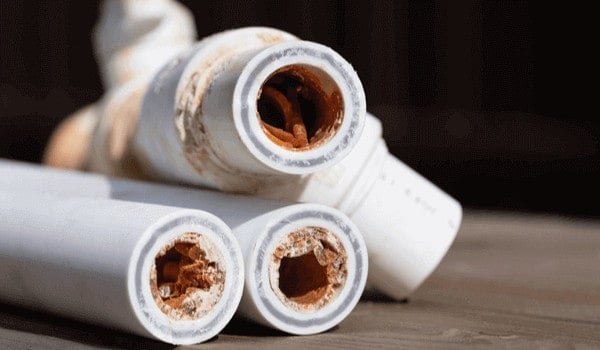
Sediment doesn’t just make water look dirty — it’s also rough on your plumbing, fixtures, and every appliance that uses water.
🔧 Here’s what it can damage:
- Pipes: Grit and sand are abrasive, leading to corrosion, pinhole leaks, and clogs over time.
- Water Heaters & Appliances: Sediment buildup reduces efficiency and shortens their lifespan. It’s especially tough on older systems — here’s how long a well pump typically lasts.
- Toilets and Fixtures: Iron and manganese can leave sticky, dark sludge that stains toilets, sinks, and tubs.
- Water Pressure: Sediment collects inside faucet aerators and pipe elbows, causing pressure to drop throughout your house.
💡 Pro Tip: If your shower pressure has dropped or your hot water smells off, sediment might be clogging your heater or pipes.
🔍 What To Do If You Spot Sediment
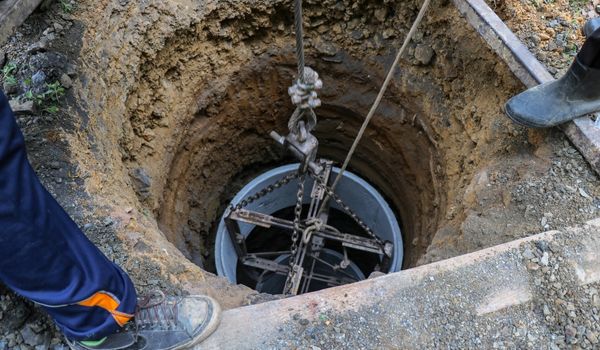
If you’re seeing dirt, cloudiness, or grit in your water, don’t panic — but don’t ignore it either. Start with a well inspection before buying filters or testing kits.
🛠️ Step 1: Inspect the Well System
Call in a pro to check:
- The well screen (first line of defense)
- The casing (cracks can let sediment leak in)
- The pump (too strong, too low, or worn pumps stir up particles)
If your hardware checks out, the next move is a water test.
🧪 Step 2: Test Your Water
Testing shows what kind of sediment you’re dealing with — and if there are any other contaminants hitching a ride.
➡️ We recommend this guide to testing your well water — it walks through your options, including how to catch issues like bacteria, iron, or manganese before they become serious problems.
💧 How to Get Rid of Sediment in Well Water

There’s no one-size-fits-all fix, but most sediment problems can be solved with the right filtration setup. Here’s a quick breakdown of your options:
| 🔧 Filter Type | 🎯 Best For | 🔍 Micron Range |
|---|---|---|
| 🔄 Spin-Down Filter | 🪨 Sand, grit, and large debris | 15–100 microns |
| 📦 Cartridge Filter | 🌫️ Fine silt & clay | 5–20 microns |
| 🧂 Water Softener | 🧱 Hardness minerals & light iron | N/A |
| 🧪 Ultrafiltration (UF) | 🦠 Microbes & tiny particles | Down to 0.1 micron |
🧼 Pro Tip: If you’re using ultrafiltration, pair it with a spin-down or cartridge filter to avoid clogging and extend membrane life.
🔄 Spin-Down Filters: Your First Line of Defense
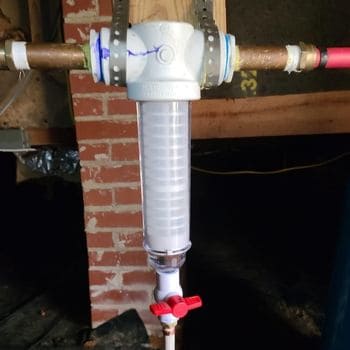
If your water looks like it came from a sandbox, this is your starting point.
Spin-down filters are installed where water enters your home. Inside, they use centrifugal force to swirl out larger particles like sand, grit, and rust flakes. These particles fall to the bottom of the chamber and can be flushed out with a quick rinse — no replacement cartridges needed.
🛠️ Why Use One?
- 🌀 Handles heavy sediment without clogging
- 🚿 Doesn’t slow down water flow like fine filters can
- 🔄 Reusable and low-maintenance
- 🧱 Great pre-filter before softeners or ultrafiltration
💡 Good to Know: Spin-down filters work best for visible sediment — not the cloudy kind. Think “pebbles in a stream,” not “mud in a puddle.”
🧻 Cartridge Filters: Fine Sediment’s Worst Enemy

If your well water looks cloudy or hazy — not gritty — cartridge filters are your go-to.
These filters come in different materials, usually: pleated paper or wound string, and they’re designed to trap finer sediment like silt, clay, and rust flakes. They’re especially helpful when used as the first stage in a multi-stage system.
🔍 What You’ll Love:
- 🧽 Removes particles as small as 5–20 microns
- 🧊 Great for polishing water before carbon or UF filters
- 🔁 Easy to swap out every few months
- 💧 Improves taste, clarity, and appliance lifespan
⚠️ Heads Up: These filters do clog over time. Always check your system’s pressure gauge — and keep a few replacements on hand.
🧰 Other Sediment Filter Options to Know

Depending on the type of sediment you’re dealing with, cartridge filters might not be enough. Let’s break down a few complementary filtration systems that can help you cover all the bases:
💎 Water Softeners
If the “sediment” in your well water is mostly hardness minerals, a traditional ion exchange softener might be your best bet. They swap calcium and magnesium with sodium, which can also help with low levels of iron and manganese.
- ✅ Use when: Your water test shows high hardness and minor metallic content
- 🚫 Don’t use alone if: You’re pulling in sand or grit — that’ll damage the softening resin.
💡 Pro Tip: Always pair a softener with a sediment pre-filter if dirt is in the mix.
🧬 Ultrafiltration (UF) Systems
UF systems use fine membranes to block particles down to 0.1 microns — great for catching things like silt, bacteria, and turbidity-causing debris.
- ✅ Use when: You want clearer water and an extra barrier against biologicals
- ⚠️ Watch out for: Reduced flow rate if your well water is very dirty
👉 See how ultrafiltration works here.
🧱 Carbon Block Filters
While not made for large sediment, carbon filters can help remove fine particles that cause cloudiness — especially after prefiltration.
- ✅ Best for: Treated water with minor haze or residual taste issues
- 🚫 Avoid using first: They’ll clog quickly on raw well water
👉 Learn more about carbon block filters here.
🧪 How to Choose the Right Sediment Filter

Not all filters are built the same. The best one for your well depends on the type and size of particles in your water — and how much water pressure you want to preserve.
Let’s break it down 👇
🔬 Micron Ratings — What They Mean
A filter’s micron rating tells you how small a particle it can catch. But smaller isn’t always better — the lower the number, the more pressure drop you’ll get.
Here’s a quick cheat sheet:
| 🔢 Micron Size | 🧱 Removes | 💡 Best For |
|---|---|---|
| 100–50 μm | Sand, grit, gravel | First-stage protection |
| 50–10 μm | Dirt, silt, rust flakes | General sediment control |
| 5–1 μm | Fine silt, clay, some bacteria | Polishing filters |
| 0.1 μm | Microorganisms, turbidity | Ultrafiltration systems |
💡 Good to Know: Choosing too fine a filter (like 1 micron) may slow your flow rate — especially if your well already has low pressure. Pick the lowest micron rating that handles your sediment without over-straining your system.
👉 Curious about how these sizes are measured? Check out our guide to micron ratings.
✅ Final Thoughts
There are bigger problems than sediment in your well water — but that doesn’t mean you should ignore it.
Sediment might not pose a serious health risk, but it can clog pipes, wear out appliances, and make your water look anything but clean. Thankfully, a good filtration setup is often all it takes to clear things up.
Whether you’re dealing with silt, sand, or rusty particles, there’s a solution that fits. From spin-downs to ultrafiltration, today’s systems are built to handle a wide range of conditions — you just need to pick the right one.
💡 Pro Tip: If your well water’s a bit of a wild card, a tailored system that handles multiple contaminants might be your best move. Here’s a look at our top picks for well water filtration setups that are built to go the distance.
Still unsure where to start? A water test and a quick inspection go a long way. With the right tools and insight, clean water isn’t just possible — it’s totally doable.
 148 people found this helpful. Was this guide helpful to you?
148 people found this helpful. Was this guide helpful to you? 

